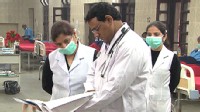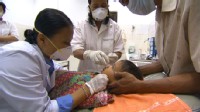Tuberculosis is growing more resistant to treatment worldwide, according to a study released Wednesday in the journal The Lancet -- a finding that suggests the potentially fatal disease is becoming more difficult and costly to treat.
Currently, 8.8 million patients worldwide are infected with tuberculosis, according to the World Health Organization (WHO). Although it is curable, the treatment regimen requires patients dutifully to take multiple antibiotics daily for several months -- and if there are any deviations from protocol or incomplete courses, drug resistance develops easily.
The WHO estimates that about 5 percent of the cases of this disease are multidrug-resistant tuberculosis, or MDR-TB -- in other words, caused by bacteria that have developed resistance to two of the first-line tuberculosis drugs, isoniazid and rifampicin.
Worse, as additional antibiotics are being thrown at the disease, forms that are even more resistant have begun to emerge. First reported in 2006, cases of extensively drug-resistant tuberculosis (XDR-TB) are resistant to drugs called fluoroquinolones, as well as to one of the three available intravenous drugs. While MDR-TB is difficult and costly to treat, XDR-TB is even harder.
The Lancet study looked at 1,278 MDR-TB patients from eight countries. The researchers found that nearly 44 percent had already developed resistance not only to the two first-line drugs, but to at least one second-line drug as well. Additionally, the researchers found that 6.7 percent of the patients had developed resistance to at least two second-line drugs -- thus classifying them as having XDR-TB.
In this study, the strongest risk factors for drug resistance were previous treatment with second-line drugs -- indicating that prior treatments were ineffectual and exacerbated the resistance of the tuberculosis. Other factors associated with resistance to second-line injectable drugs were unemployment, a history of imprisonment, alcohol abuse and smoking.
The study, known as the Preserving Effective TB Treatment Study (PETTS), was launched by the International Working Group on MDR tuberculosis and coordinated through the health departments in Estonia, Latvia, Peru, Philippines, Russia, South Africa, South Korea and Thailand. Drug-susceptibility testing was performed at the U.S. Centers for Disease Control and Prevention.
The figures offered by the new study, though alarming, appear to be close to what international health officials expected. While the new number is higher than a figure in a 2010 WHO report, which indicated that only 5.4 percent of MDR-TB patients had XDR-TB in the same time period, an even more recent update by the WHO estimates a prevalence of 9.4 percent of MDR-TB patients with the XDR-TB mutations.
"The global emergency of extensively drug-resistant tuberculosis heralds the advent of widespread, virtually untreatable tuberculosis," lead author Tracy Dalton of the Centers for Disease Control writes in the report.
Because tuberculosis can easily be transmitted through droplets in the air -- as occurs when someone with the disease coughs -- the disease is a menace to public health. In 2010, 1.1 million people worldwide died from tuberculosis.




No comments:
Post a Comment